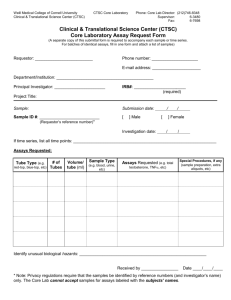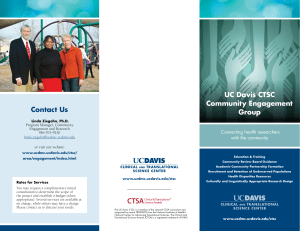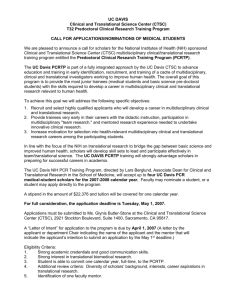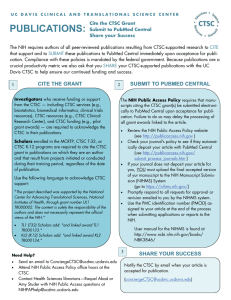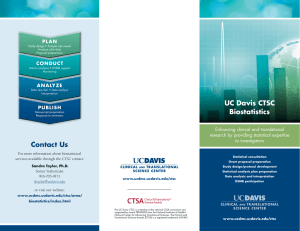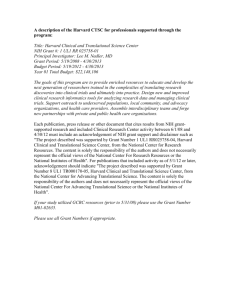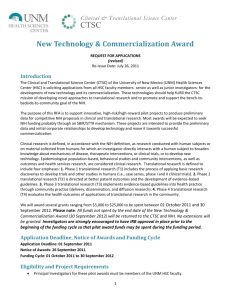Diana L. Farmer – the accidental translational scientist
advertisement
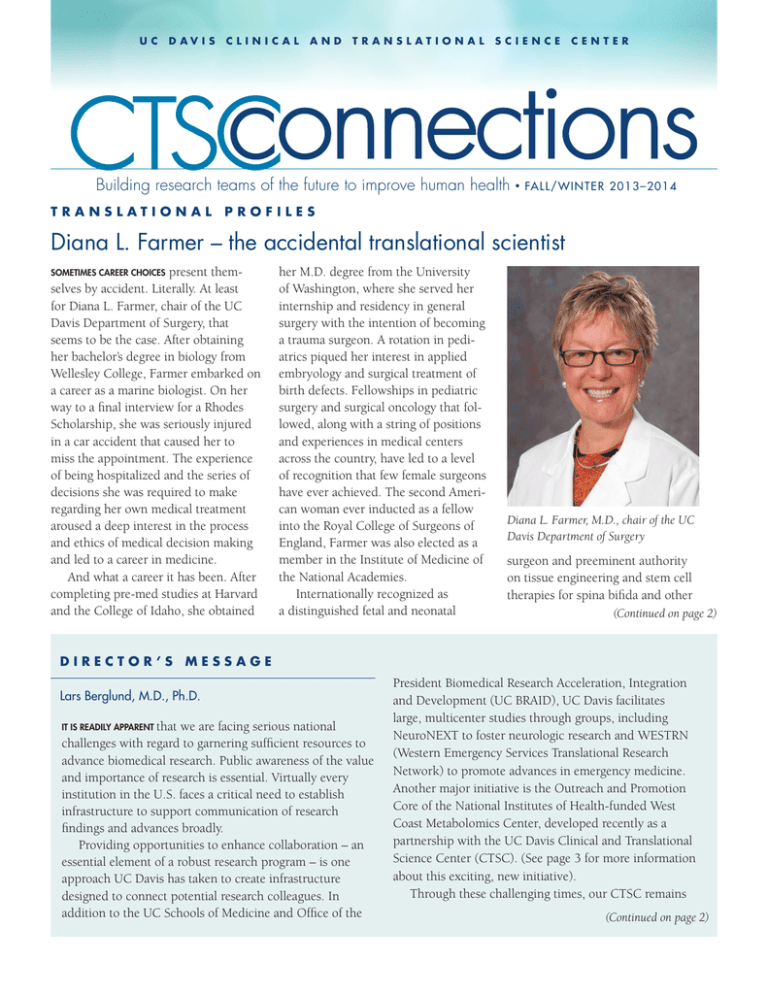
UC D AV I S CLINICAL AND TRANSLATIONAL SCIENCE CENTER Building research teams of the future to improve human health • FAL L /WINT ER TRANSLATIONAL 2013–2014 PROFILES Diana L. Farmer – the accidental translational scientist present themselves by accident. Literally. At least for Diana L. Farmer, chair of the UC Davis Department of Surgery, that seems to be the case. After obtaining her bachelor’s degree in biology from Wellesley College, Farmer embarked on a career as a marine biologist. On her way to a final interview for a Rhodes Scholarship, she was seriously injured in a car accident that caused her to miss the appointment. The experience of being hospitalized and the series of decisions she was required to make regarding her own medical treatment aroused a deep interest in the process and ethics of medical decision making and led to a career in medicine. And what a career it has been. After completing pre-med studies at Harvard and the College of Idaho, she obtained SOMETIMES CAREER CHOICES her M.D. degree from the University of Washington, where she served her internship and residency in general surgery with the intention of becoming a trauma surgeon. A rotation in pediatrics piqued her interest in applied embryology and surgical treatment of birth defects. Fellowships in pediatric surgery and surgical oncology that followed, along with a string of positions and experiences in medical centers across the country, have led to a level of recognition that few female surgeons have ever achieved. The second American woman ever inducted as a fellow into the Royal College of Surgeons of England, Farmer was also elected as a member in the Institute of Medicine of the National Academies. Internationally recognized as a distinguished fetal and neonatal Diana L. Farmer, M.D., chair of the UC Davis Department of Surgery surgeon and preeminent authority on tissue engineering and stem cell therapies for spina bifida and other (Continued on page 2) DIRECTOR’S MESSAGE Lars Berglund, M.D., Ph.D. IT IS READILY APPARENT that we are facing serious national challenges with regard to garnering sufficient resources to advance biomedical research. Public awareness of the value and importance of research is essential. Virtually every institution in the U.S. faces a critical need to establish infrastructure to support communication of research findings and advances broadly. Providing opportunities to enhance collaboration – an essential element of a robust research program – is one approach UC Davis has taken to create infrastructure designed to connect potential research colleagues. In addition to the UC Schools of Medicine and Office of the President Biomedical Research Acceleration, Integration and Development (UC BRAID), UC Davis facilitates large, multicenter studies through groups, including NeuroNEXT to foster neurologic research and WESTRN (Western Emergency Services Translational Research Network) to promote advances in emergency medicine. Another major initiative is the Outreach and Promotion Core of the National Institutes of Health-funded West Coast Metabolomics Center, developed recently as a partnership with the UC Davis Clinical and Translational Science Center (CTSC). (See page 3 for more information about this exciting, new initiative). Through these challenging times, our CTSC remains (Continued on page 2) Diana Farmer Continued from page 1 childhood disorders, Farmer could land a prestigious position with practically any academic medical institution of her choosing. Her decision to accept a position at UC Davis was no accident. Farmer developed strong familiarity with UC Davis in the late ’90s, after joining UC San Francisco Medical Center and Children’s Hospital, where she became clinical director of children’s surgical services. Farmer’s use of sheep as an investigational model in some of her studies of myelomeningocele, a form of spina bifida, prompted her search for an institution that integrates translational pathways among human and veterinary medicine scholars. “One of the things that attracted me here was that the whole time I was at UCSF, I had always done my fetal sheep surgery research at the UC Davis School of Veterinary Medicine,” Farmer said. “The CTSC also attracted me to UC Davis. I definitely think of that as a very strong asset, particularly for some- one like me who is interested in translational work. Having the support of a CTSC is critically important. My work at UCSF translating the lab work that we had done in sheep to human physiology was augmented by the availability of the Clinical and Translational Science Institute (CTSI) there, and having that as a resource here is important. I was impressed to learn that UC Davis has one of the first CTSAs.” Farmer’s interest in global and rural health care also influenced her decision to join the UC Davis faculty. “UC Davis is the only academic medical center that is committed to inland California, serving a rural population segment,” said Farmer, a Chicago native whose family relocated to Boise, Idaho, when she was a teenager. “The kind of training that you need to be skilled in a rural health-care environment as a surgeon is similar to what you need in an international or global health environment, and some of the maldistribution problems in the workforce in America are not that dissimilar to rural workforce maldistributions in developing countries.” Farmer concluded that all of her interests would best be served by joining UC Davis in 2011 as chair of the Department of Surgery, where she holds the Pearl Stamps Stewart endowed professorship. She also is surgeon-in-chief of UC Davis Children’s Hospital. “I have found the interdisciplinary opportunities at UC Davis really attractive,” said Farmer, who is conducting clinical trials on the effectiveness and safety of fetal spina bifida treatments. “We have easy access to collaborate with our colleagues in biomedical engineering and in veterinary medicine, and can bring all of those to bear on human health as well.” Perhaps serendipity is a better word to describe the accident that was instrumental in creating this prominent surgeon and translational scientist. DIRECTOR’S MESSAGE continued from page 1 Lars Berglund, M.D., Ph.D. 2 committed to its three overarching goals: • Provide a comprehensive array of tools and services to support research. • Ensure the availability of a wellprepared workforce of trainees, staff and investigators. • Support innovative translational science advancements to improve human health. By means of this integrated support structure, the CTSC constitutes a time-tested mechanism to catalyze and help advance a variety of research projects. We are also now poised to offer additional assistance by connecting researchers with services and resources through our new Concierge Service. We made this service accessible through our website to enable us to better support the research community and facilitate collaborative opportunities. (More on page 7.) As a major research university and as a national leader, UC Davis has much to offer the broader research enterprise. Yet, significant impediments remain. Engagement of the community and stakeholders – including patient-focused networks – in the research process represents a path toward the future, and we must become actively involved in order to avoid being left behind. UC Davis Clinical and Translational Science Center • Fall/Winter 2013–2014 COLLABORATION Metabolomics Center offers technological windows to observe disease pathways only in a hypothesis-driven approach, ‘omics’ community recently but also in a discovery-driven mode. received a boost with funding for the That is the big distinction between UC Davis West Coast Central Compreclassical clinical chemistry and the hensive Metabolomics Resource Core, known as the West Coast Metabolomics ‘omics’ disciplines. “A researcher investigating a complex disease is Center (WCMC). The funding of the no longer constrained to a single WCMC – which was one of only three hypothesis. Metabolomics can such core facilities initially funded by accommodate numerous variables the National Institutes of Health (NIH) by testing 50 or more hypotheses in September 2012 (the total has since simultaneously,” said Fiehn. “Testing increased to six) – acknowledges that UC Davis is at the forefront of metabolomics research. Housed within the Genome Center on the Davis campus, the WCMC is a consortium of eight research and service laboratories encompassing 35 mass spectrometers, five nuclear magnetic resonance instruments and advanced statistical software to process highly complex data. The explosion of improved computational and other technologies during the past 15 years has fostered evolution of the ‘omics’ fields – including Detectable Metabolites genomics, proteomics, and only one hypothesis is no longer metabolomics. Metabolomics profiles considered innovative.” the chemical byproducts of cellular Fiehn ought to know; together metabolism, offering a means to with other like-minded biochemists, improve understanding of biochemical he helped define the discipline processes and thereby gain new of metabolomics. Scientists first insights about disease and potential described the metabolomics concept targets for treatment. as an abstract idea they called “Metabolomics uses fast “profiling” in the 1960s, but without computers and new technologies a practical means to achieve it. Since to very broadly analyze numerous his seminal metabolomics papers in nutritional or xenobiotic compounds 2000, Fiehn conceived a structural and endogenous metabolites in a framework for the discipline. Now short time frame,” explained Oliver he thrives in the discipline he helped Fiehn, professor of molecular and create. Fiehn’s recent work includes cellular biology and director of the drug response metabolism studies WCMC. Using metabolomics methods, (pharmacometabolomics) that link investigators can conduct studies not THE UC DAVIS UC Davis Clinical and Translational Science Center • Fall/Winter 2013–2014 metabolomics data to single nucleotide polymorphisms (SNPs) in patient populations, thus explaining why certain patient cohorts respond to drug treatments and others do not. Metabolomics offers a means of answering clinical questions in a way that is both novel and complementary to other disciplines. The object of interest in metabolomics studies – the metabolite – is the ultimate output of a cell, and as such, is much closer to the disease or “endpoint” that is clinically interesting. In other words, the metabolite is closer to the phenotype (observable characteristics) of an organism than the genotype (hereditary profile). Using genotypic data only, a scientist studying massive numbers of people may have difficulty linking genotypes studied with the phenotypes, or characteristics, of interest. “Using the results of both metabolomics and genomics, you can trace your work from the metabolite level to genotypic variations,” Fiehn explains. “My lab has published at least eight papers on this topic. Together with a consortium led by Rima Kaddurah-Daouk [of Duke University], we used metabolomics to reveal the responses of clinical patients to pharmaceutical interventions in depression, hypertension, high cholesterol and other diseases. We mapped the biochemistry of patients with good responses to therapy and compared these findings with data from those who responded poorly. This information was then used to inform genome-wide association studies to identify SNPs that could potentially (Continued on page 4) 3 COLLABORATION Continued from page 3 predict which patients – based on their genomic and metabolomic profiles at baseline – might benefit from therapy.” The WCMC offers comprehensive, fee-based data analysis services for preclinical, clinical and translational science researchers. Oliver Fiehn, Ph.D., Fiehn describes director of the WCMC the WCMC as a service center that responds to the basic and clinical research needs of the biomedical community. During the 2012–13 academic year, the center processed approximately 12,000 samples for 165 studies. “We have a full-time statistician to help researchers with everything from power calculations and study design to pathway mapping and interpretation of data, which can be areas of difficulty for clinicians and metabolomics researchers,” Fiehn said. “We aid in study design and in the interpretation of data.” The WCMC also has an Outreach and Promotion Core that includes educational offerings and a pilot program co-led by Lars Berglund, director of the UC Davis CTSC, and Alice Tarantal, director of the CTSC Pilot Translational and Clinical Studies Program and Translational Technologies, Methodologies and Resources Program. This past spring, in collaboration with the CTSC, the WCMC reviewed and funded pilot awards of up to $50,000 in metabolomic services for clinical and translational research studies. The pilot projects funded are focused on enriching existing human cohort or animal model studies, and supporting metabolomics research for new or ongoing studies. “The CTSC helps researchers conduct pilot studies and organize reviews and ongoing evaluations of funded projects through progress reports,” Fiehn said. “We enrich CTSC educational programs by providing metabolomics instruction to physicians and biomedical researchers enrolled in their courses. Our services and courses are open to everyone, not just affiliates of the UC system, and we have projects with many clinicians and scientists across the U.S. We are working to build a relationship with other institutions in the CTSA consortium,” said Fiehn, who expects the WCMC to offer another pilot funding round within the next few months. The WCMC conducts educational courses, symposia and monthly seminars explaining applications of metabolomics in translational science. Fiehn hopes that the center, which was established with a five-year, $9.3 million NIH startup grant in 2012, will be self-supporting by 2017. For information visit http:// metabolomics.ucdavis.edu/ where database applications and other software utilities are available for downloading. AT YOUR SERVICE New CTSC Concierge Service more about how you might best benefit from CTSC resources before submitting a formal request? Do you want to follow up on a request for services you’ve already submitted? Are you having difficulty finding the information you need about the CTSC for a grant proposal? If you answered “yes” to any or all of those questions, you are in luck! The CTSC now has a Concierge Service to assist investigators and staff with navigating their way to appropriate resources. The CTSC Concierge Service is intended to serve as the primary contact for questions regarding CTSC services, programs, website and events. While Concierge duties will be shared among several staff members, the service lead for the Concierge Service is Christine Hotz, CTSC Program Development Officer. DO YOU WANT TO KNOW 4 The CTSC is excited to offer this new service to investigators and staff as a streamlined way to get help and advice. Contact the CTSC Concierge Service to: • Arrange for a consultation about CTSC services • Check on the progress of requests for CTSC services • Get assistance with the process for the NIH Public Access Policy for publications Schedule a presentation about CTSC services for your department or group Locate forms, documents and information on the CTSC website Provide questions and comments about CTSC services • • • There are three primary ways to access the CTSC Concierge Service: 1) Email the service desk directly at ConciergeCTSC@ucdmc.ucdavis.edu; 2) Ring the virtual Concierge bell by clicking the Concierge button on the CTSC home page; and 3) Phone the Concierge desk at 916-7039128. UC Davis Clinical and Translational Science Center • Fall/Winter 2013–2014 FEATURED SCHOLAR Daniel K. Nishijima At a Glance • • • • • • Assistant professor of emergency medicine Joined the UC Davis faculty in 2008 Completed CTSC Mentored Clinical Research Training Program in conjunction with emergency medicine research fellowship In final year of CTSC K12 Mentored Career Development Program Research interest: traumatic brain injury Research mentors: James Holmes, professor of emergency medicine, and Joy Melnikow, professor of family and community medicine What are you most passionate about in your work? One thing that has inspired me to conduct research is that it is very hard! To conduct impactful and methodologically sound research requires a lot of blood, sweat and tears. Above all, as our department chair Nate Kuppermann preaches, research requires persistence. The challenges and difficulties of doing research are very exciting. I enjoy pushing myself to acquire new skills and methodology, and to generate solutions to complicated problems. The beautiful thing is that these challenges never seem to disappear during your career; they evolve and present themselves in new and unique ways. am planning a patient-centered, randomized controlled trial evaluating admission strategies for low-risk adult patients with TBI. What or who inspired you to seek a career in medicine and research? What’s important about your research and where do you hope to take it? How have the MCRTP and K12 programs helped you become a better researcher? Having my research translated to real-world clinical practice that improves patient care is the most rewarding aspect of conducting research. I am also particularly excited about conducting emergency care research which, while challenging, is broad and involves working with a diverse group of collaborators. I credit my decision to pursue and continue a career in research to a strong mentorship foundation, from people both inside and outside of UC Davis. They have provided guidance not only on research methodology but also on career and life. In addition, our department is fantastic; our faculty is always so willing to provide insights and perspective to my research. Traumatic brain injury (TBI) is a significant public health concern in this country, responsible for 1.4 million emergency room visits, 52,000 deaths, and $60 billion of expenditure every year, according to a Centers for Disease Control and Prevention (CDC) estimate. My research interest in TBI revolves around two foci: evaluating resource utilization in the management of TBI patients, and investigating TBI in patients who previously were on anticoagulants (blood thinners). I recently was awarded a three-year cooperative agreement (U01) from the CDC to evaluate older adults with TBI and pre-injury anticoagulation use, involving 11 hospitals and five emergency medical services agencies within Sacramento County. I also I view these years of mentored clinical research training as a critical phase in my career that allowed me time to focus on my research, develop new skills, establish multidisciplinary collaborations and familiarize myself with UC Davis CTSC resources. These years have also allowed me to be productive. I have completed two multicenter studies, 22 publications and numerous intramural and extramural funded projects. In addition, I recently was awarded the 2013 Society of Academic Emergency Medicine Young Investigator Award. I believe that at the end of my training, I’ll have the confidence to undertake large-scale, multi-center studies that can really benefit patient care. UC Davis Clinical and Translational Science Center • Fall/Winter 2013–2014 5 CTSC SCHOLAR MEETS WITH CONGRESS Discusses the importance of translational research VETERINARIAN MORTEZA ROODGAR, a UC Davis graduate student in comparative pathology and CTSC T32 scholar, is in search of a silent threat lurking in the bodies of 2 billion people. The threat is tuberculosis (TB), and Roodgar is working to develop a more efficient means of diagnosis. “One-third of the human population worldwide is infected latently with the TB bacterium, and they don’t know it,” Roodgar explains. “They are carriers of tuberculosis but do not have clinical symptoms. The Mantoux tuberculin was complex, afflicted humans with a variety of clinical presentations, and had the potential for animal-to-human transmission. TB, a major public health concern, met Roodgar’s requirements as a target for study. “Dairy cows and other animals with TB can infect humans through their products. Some people are susceptible to the disease, while others are resistant. I realized that the answer to that mystery is not just in the bacteria,” he said. “I became interested in host genes that regulate immune responses to TB, and I wanted to learn more about the cellular and molecular aspects of disease, rather than just the gross pathology.” With molecular anthropologist and geneticist David Glenn Smith, a professor in the College of Letters and Science, as his mentor, Roodgar was awarded a CTSC T32 training grant in 2012. “Dr. Smith agreed to U.S. Sen. Dianne Feinstein with Morteza Roodgar, D.V.M., provide laboratory space M.P.V.M. Photo courtesy of UC Government and Community for my research, which Relations, Office of the Chancellor and Provost. focused on identifying and exploring five test, which was developed a century genetic biomarkers that might correlate ago, is only 59.7 percent accurate in with susceptibility to tuberculosis in identifying TB-positive cases, and it nonhuman primates,” said Roodgar. A cannot detect latent TB at all.” subsequent test of these biomarkers in Latent TB infection is particularly macaques, an important animal model problematic for people who become of human TB, has shown promise, infected with the human immunodeand Roodgar hopes to study human ficiency virus (HIV), because they will subjects eventually. These biomarkers develop active TB due to the immunoultimately could be used to develop a suppressive effects of HIV. Under these new diagnostic test for TB – one that is circumstances, treatment becomes both more sensitive than the Mantoux more complicated. test and is also able to identify latent Roodgar decided on TB as the focus infections. of his graduate work after a careful Earlier this year, Roodgar’s project search for an infectious disease that he caught the attention of faculty would find challenging – a disease that members interested in high-impact 6 research projects with the potential for commercialization. This group nominated Roodgar to the UC Davis Office of the Chancellor to meet with members of Congress in Washington, D.C., as part of the annual UC Day in DC, a government advocacy program sponsored by the UC Office of the President. At the event, which took place last May, Roodgar met with Reps. John Garamendi, Doris Matsui and Ami Bera, as well as Sen. Dianne Feinstein, and discussed the highimpact implications of his research and how well positioned UC Davis is for translational research. “Having a medical school, veterinary school, primate research center and the important connecting role that the UC Davis CTSC provides cannot be understated,” Roodgar said. “That combination provides a unique opportunity for conducting translational biomedical research.” Roodgar found the trip to D.C. an altogether memorable experience that included carefully explaining scientific ideas to nonscientists – in this case, politicians. “I had to keep reminding myself that I should not use any scientific terms that they might not understand,” he recalled. Back at UC Davis, Roodgar fully intends to continue to use many of the CTSC resources available to translate his research into a product with the potential of saving many lives – human and nonhuman alike. To this end, Roodgar recently completed a business fellowship with the UC Davis Graduate School of Management. In this program he gained insight about translational and commercialization prospects for the new TB test – yet another demonstration of Roodgar’s ability to parlay diverse collections of interdisciplinary expertise into a comprehensive plan for translational science. UC Davis Clinical and Translational Science Center • Fall/Winter 2013–2014 Thank you for citing our grant! Now please obtain your PMCID. Meeting the NIH requirement for Public Access know they are expected to acknowledge the grant that funded their research by citing the grant number in manuscripts, presentations, press releases and other published materials, including those posted on the web. Many investigators and scholars recognize that this expectation also extends to them, as users of CTSC resources, recipients of CTSC pilot awards, and scholars or trainees enrolled in CTSC training programs, because the CTSC is supported by an NIH grant. MOST NIH-SUPPORTED PRINCIPAL INVESTIGATORS What may have escaped the attention of some recipients of CTSC services or training is that, in addition to citing the CTSC grant number, the manuscript also must meet the NIH requirement for public access. According to the NIH website, “The NIH Public Access Policy ensures that the public has access to the published results of NIHfunded research to help advance science and improve human health.” To comply with this policy, any research manuscript accepted for publication must be submitted to PubMed Central (PMC), and a PubMed Central ID (PMCID) must be obtained for it. The PMCID is the reference number assigned to a manuscript at the end of the submission process. Investigators must supply the PMCID for publication citations included in their NIH biosketch and progress reports (http://publicaccess.nih.gov/citation_ methods.htm). The submission process is relatively simple and begins by uploading the final peer-reviewed manuscript to PMC through the NIH Manuscript Submission (NIHMS) system (the portal to PMC). Many journals will initiate the required steps to ensure that publications are compliant with the NIH Public Access Policy. However, for manuscripts published in journals that do not perform this service, the responsibility falls to one of the authors (or other designated person) to shepherd the article though its journey in the NIHMS system. The NIH already has begun to enforce its Public Access Policy, and some investigators have experienced the consequences of noncompliance. As of this past July 1, failure to submit a manuscript to PMC within NIHimposed deadlines can result in a delay of processing certain grant awards and noncompetitive renewals. This mandate includes out-of-compliance articles dating back to 2008. The CTSC is tracking publications that cite the CTSC grant, but are not yet deposited into PubMed Central. CTSC staff will follow up with authors of noncompliant articles to help facilitate compliance with the Public Access Policy. Please note that the ramifications of noncompliance also apply to the CTSC grant, as funding will be withheld if investigators supported through the use of CTSC resources do not comply with this policy. As of this past July 1, failure to submit a manuscript to PMC within NIH-imposed deadlines can result in a delay of processing certain grant awards and noncompetitive renewals. This mandate includes out-ofcompliance articles dating back to 2008. The health science and medical librarians and CTSC staff will offer a workshop in early 2014 to help investigators and staff work though the compliance process, from citing a grant to obtaining a PMCID number. The accompanying inset contains links to important details about this process. The last page of this newsletter lists additional online resources. Investigators are encouraged to be proactive and to ensure they comply with the NIH Public Access Policy. If you have not been able to resolve technical difficulties with the online NIHMS system or have questions about the process, please send an email to ConciergeCTSC@ucdmc.ucdavis.edu. Quick and easy guide to satisfying NIH Public Access Policy requirements Step 1 – Cite the CTSC grant in your manuscript. http://www.ucdmc.ucdavis.edu/ctsc/audience/investigators/ ctsc_publication_citing.html Step 2 – When your manuscript is accepted for publication, determine applicability of the NIH policy to your manuscript. http://publicaccess.nih.gov/determine_applicability.htm Step 3 – Review your publishing agreement to identify any copyright conflicts. http://publicaccess.nih.gov/address_copyright.htm Step 4 – Submit your manuscript to PubMed Central (PMC) through the NIH Manuscript Submission (NIHMS) system. http://publicaccess.nih.gov/submit_process.htm Step 5 – Shepherd the manuscript through the NIHMS system, noting the PMCID at the end of the process. Step 6 – Send an email to ConciergeCTSC@ucdmc.ucdavis.edu with your PMCID. UC Davis Clinical and Translational Science Center • Fall/Winter 2013–2014 7 CLINICAL AND TRANSLATIONAL SCIENCE CENTER 2921 Stockton Blvd., Suite 1400 Sacramento, CA 95817 ADDRESS SERVICE REQUESTED Links to resources about NIH Public Access Policy UC Davis Library resource page about NIH Public Access Mandate A well-organized collection of links to information and training materials about Public Access and the NIH Manuscript Submission (NIHMS) System: http://guides.lib.ucdavis.edu/friendly.php?s=nih_mandate Public Access home page: http://publicaccess.nih.gov/index.htm Public Access training materials and communications page: http://publicaccess.nih.gov/communications.htm Public Access Policy Training Webinars: http://grants.nih.gov/grants/webinar_docs/webinar_20130115.htm Overview of NIH Public Access Policy (video from NYU Langone Medical Center): https://www.brainshark.com/nyulmc/vu?pi=zJ5zr7tKsz2vpuz0&intk=280979910 NIHMS System (login): http://www.nihms.nih.gov/ NIHMS FAQs and submission tutorials: http://www.nihms.nih.gov/help/#slideshow Public Access Policy details and announcements: http://publicaccess.nih.gov/policy.htm Find us on Facebook https://www.facebook.com/UcDavisClinicalAndTranslationalScienceCenter The UC Davis CTSC is a member of the national CTSA consortium and supported by award TR000002 from the National Institutes of Health’s National Center for Advancing Translational Sciences. CTSC Connections is published twice a year by the UC Davis Health System. To add your name to the mailing list, send an e-mail to CTSCMail@ucdmc.ucdavis.edu. http://www.ucdmc.ucdavis.edu/ctsc/ Executive Editor Lars Berglund Managing Editor Kitty Lombardo Creative Director Christine Hotz Editors Carole Gan Alice Tarantal Writing EditPros LLC The University of California does not discriminate on the basis of race, color, national origin, religion, sex, sexual orientation, disability, age, veterans’ status, medical condition, ancestry or marital status. The University of California is an affirmative action/equal opportunity employer. Call 530-752-2071 for more information. Speech or hearing-impaired persons may call 530-752-7320 (TDD).
